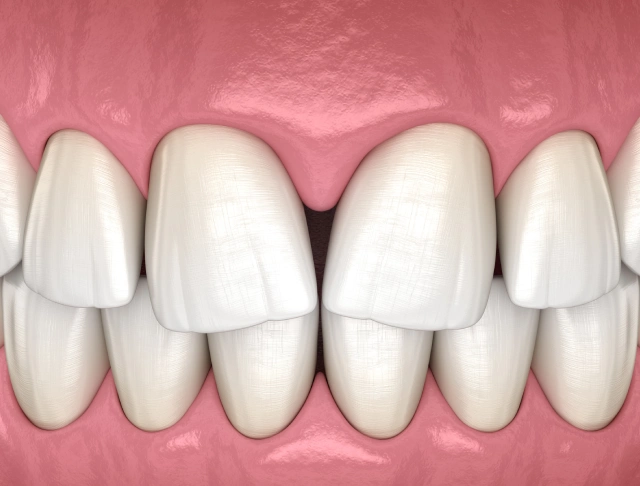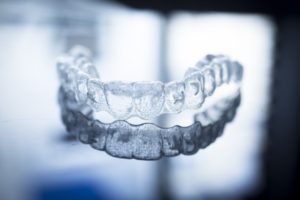Several factors can contribute to the development or exacerbation of gaps between the teeth. These include:
Genetics:
Genetics play a significant role in determining the size and alignment of teeth. Inherited traits can influence tooth size, shape, and jawbone structure, which in turn can affect the spacing between teeth. Individuals may inherit genes that predispose them to smaller teeth or jawbones with insufficient space, leading to gaps between the teeth. Additionally, genetic factors can contribute to conditions such as missing teeth or abnormalities in tooth development, which may also result in gaps. Understanding the genetic influence on dental characteristics is essential for comprehensively addressing gaps between teeth and planning appropriate treatment strategies.
Missing Teeth:
The absence of one or more teeth, known as missing teeth or tooth loss, can contribute to the development of gaps between teeth. When a tooth is missing, neighboring teeth may shift position over time, seeking to fill the space left by the missing tooth. This shifting can result in gaps between the remaining teeth, altering the alignment of the dental arch. The degree of gap formation depends on various factors, including the location of the missing tooth, the surrounding teeth' stability, and the duration of tooth loss. Missing teeth can occur due to various reasons, such as dental trauma, tooth decay, gum disease, or congenital conditions. Addressing missing teeth promptly through restorative treatments like dental implants, bridges, or partial dentures can help prevent further gap development and restore proper dental alignment and function. Regular dental check-ups and timely intervention for missing teeth are essential for maintaining optimal oral health and preventing complications associated with tooth loss.
Overgrown Gum Tissue:
Excessive gum tissue, medically referred to as gingival hyperplasia, is another factor contributing to the widening of gaps between teeth. When gum tissue grows excessively, it can encroach on the space between teeth, causing them to appear more widely spaced. This overgrowth may result from various factors, including genetics, hormonal changes, certain medications, or chronic irritation to the gums. Additionally, an overgrown labial frenum, the tissue connecting the upper lip to the gums, can exert pressure on the teeth, pushing them apart and creating visible gaps. Understanding the role of overgrown gum tissue in the development of teeth gaps is crucial for implementing appropriate treatment strategies. Periodontal treatments, such as gum contouring or surgical procedures, may be necessary to address excessive gum tissue and reduce the size of the gaps between teeth. Regular dental examinations and professional cleanings are essential for monitoring gum health and addressing any issues contributing to the widening of teeth gaps.
Small Teeth:
Small teeth, also known as microdontia, can contribute to the widening of gaps between teeth. When teeth are smaller in proportion to the jawbone or surrounding teeth, they may not adequately fill the available space in the dental arch. This can result in gaps between teeth, especially in areas where neighboring teeth are larger or there is excessive space. Small teeth can be a genetic trait inherited from family members or may result from developmental abnormalities during tooth formation. Additionally, conditions like enamel hypoplasia, where teeth have inadequate enamel, can also cause teeth to appear smaller. Addressing small teeth and associated gaps may require orthodontic treatments like braces or clear aligners to realign teeth and close the gaps. Dental bonding or veneers may also be used to reshape and enlarge small teeth, improving their appearance and closing gaps. Understanding the role of small teeth in the development of gaps is essential for creating effective treatment plans to address this issue and restore proper dental alignment and aesthetics.
Extra Teeth:
The presence of additional teeth, a condition known as hyperdontia, can contribute to the widening of gaps between teeth. Extra teeth can cause crowding and spacing issues within the dental arch, disrupting the natural alignment of teeth. These additional teeth may develop in various locations within the jawbone, including the front or back of the mouth. When extra teeth erupt, they can exert pressure on neighboring teeth, causing them to shift positions and create gaps. The development of extra teeth can be influenced by genetic factors or certain medical conditions. Understanding the role of hyperdontia in tooth alignment is crucial for addressing gaps between teeth effectively. Treatment for hyperdontia may involve extraction of the extra teeth and orthodontic intervention to correct any resulting misalignment. By addressing the underlying cause of extra teeth and managing their impact on dental alignment, gaps between teeth can be minimized or prevented, promoting optimal oral health and aesthetics.
Poor Oral Hygiene:
Inadequate oral hygiene practices, such as irregular brushing and flossing, can contribute to gum disease and tooth decay, which may result in tooth loss and subsequent gap formation.
Trauma or Injury:
Accidents or trauma to the mouth can cause damage to teeth or supporting structures, leading to tooth loss or misalignment that may contribute to teeth gaps.
Unhealthy Habits:
Certain habits like nail-biting or chewing on hard objects can exert excessive pressure on teeth, potentially causing them to shift position and create gaps.
By addressing these preventable causes through proper oral hygiene, avoiding harmful habits, and seeking prompt dental care for any injuries or trauma, individuals can reduce the risk of teeth gaps widening over time. Regular dental check-ups are also essential for detecting and addressing any issues early to maintain optimal oral health and prevent the progression of teeth gaps.
Addressing the question of why tooth gaps increase involves understanding the various treatment options available to correct these gaps and improve overall dental alignment and aesthetics. Orthodontic treatments, such as braces or clear aligners, are commonly used to gradually shift teeth into proper alignment, closing gaps in the process. Braces apply gentle pressure to move teeth into their desired positions over time, while clear aligners offer a discreet and removable alternative for straightening teeth. Dental bonding, or veneers, may also be used to fill in gaps and improve the appearance of the smile. Dental bonding involves applying a tooth-colored composite resin to the teeth to close gaps and reshape teeth as needed. Veneers, thin shells made of porcelain or composite material, are custom-made to cover the front surface of teeth and can effectively mask gaps and other cosmetic imperfections. The choice of treatment depends on various factors, including the severity of the gaps, overall dental health, and patient preferences. Consulting with a qualified dentist or orthodontist is essential for determining the most suitable treatment plan to address tooth gaps effectively and achieve the desired aesthetic results.
We understand the importance of addressing the underlying reasons why tooth gaps increase. Our comprehensive dental services offer personalized treatment plans tailored to each individual's unique needs, whether it is a genetic factor, missing teeth, or overgrown gum tissue causing the gaps. From orthodontic treatments like braces or clear aligners to cosmetic procedures like dental bonding or veneers, we provide a range of solutions to improve dental alignment and aesthetics. With state-of-the-art facilities and a dedicated team, we strive to ensure our patients receive the highest quality care in a comfortable environment. Visit our website at mathewdds.com to schedule a consultation and let us help you achieve a healthier, more confident smile.






